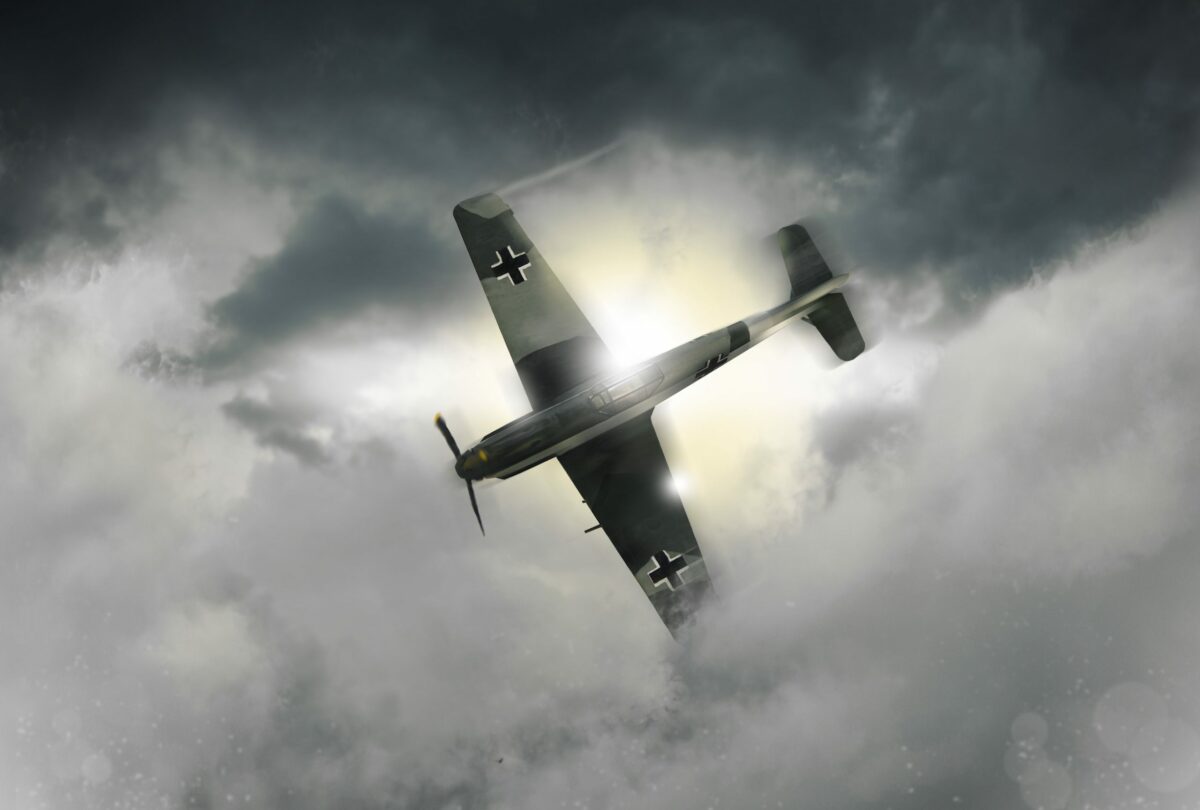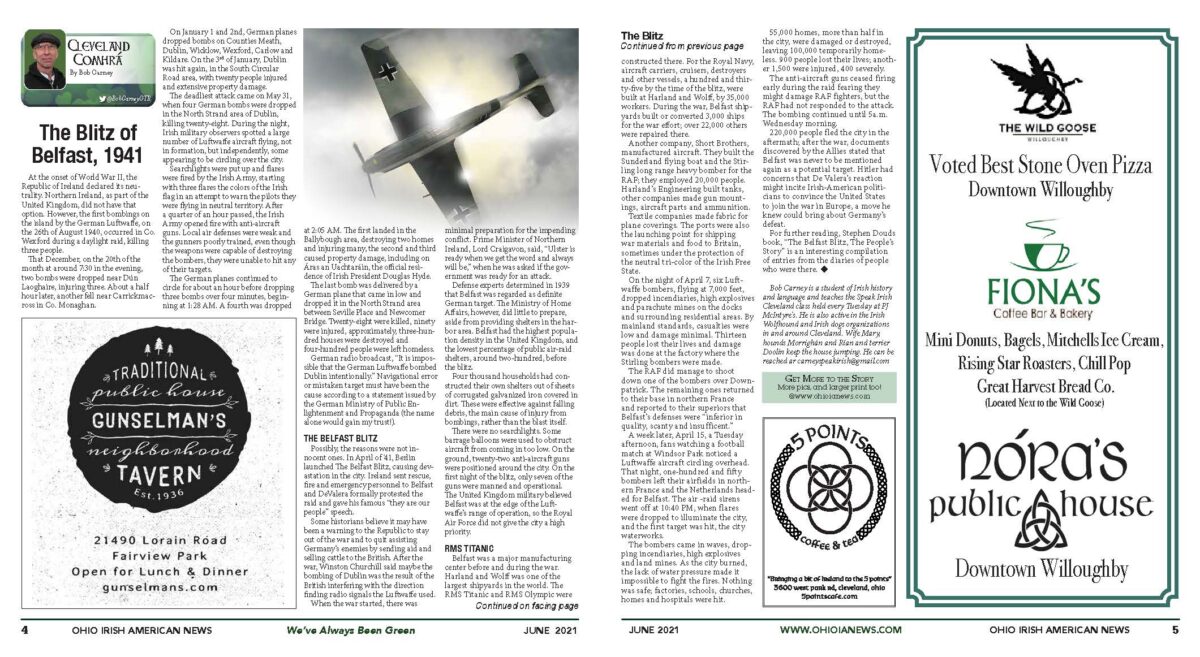

Cleveland Comhrá: The Blitz of Belfast, 1941
By Bob Carney
At the onset of World War II, the Republic of Ireland declared its neutrality. Northern Ireland, as part of the United Kingdom, did not have that option. However, the first bombings on the island by the German Luftwaffe, on the 26th of August 1940, occurred in Co. Wexford during a daylight raid, killing three people.
That December, on the 20th of the month at around 7:30 in the evening, two bombs were dropped near Dún Laoghaire, injuring three. About a half hour later, another fell near Carrickmacross in Co. Monaghan.
On January 1 and 2nd, German planes dropped bombs on Counties Meath, Dublin, Wicklow, Wexford, Carlow and Kildare. On the 3rd of January, Dublin was hit again, in the South Circular Road area, with twenty people injured and extensive property damage.
The deadliest attack came on May 31, when four German bombs were dropped in the North Strand area of Dublin, killing twenty-eight. During the night, Irish military observers spotted a large number of Luftwaffe aircraft flying, not in formation, but independently, some appearing to be circling over the city.
Searchlights were put up and flares were fired by the Irish Army, starting with three flares the colors of the Irish flag in an attempt to warn the pilots they were flying in neutral territory. After a quarter of an hour passed, the Irish Army opened fire with anti-aircraft guns. Local air defenses were weak and the gunners poorly trained, even though the weapons were capable of destroying the bombers, they were unable to hit any of their targets.
The German planes continued to circle for about an hour before dropping three bombs over four minutes, beginning at 1:28 AM. A fourth was dropped at 2:05 AM. The first landed in the Ballybough area, destroying two homes and injuring many, the second and third caused property damage, including on Áras an Uachtaráin, the official residence of Irish President Douglas Hyde.
The last bomb was delivered by a German plane that came in low and dropped it in the North Strand area between Seville Place and Newcomer Bridge. Twenty-eight were killed, ninety were injured, approximately, three-hundred houses were destroyed and four-hundred people were left homeless.
German radio broadcast, “It is impossible that the German Luftwaffe bombed Dublin intentionally.” Navigational error or mistaken target must have been the cause according to a statement issued by the German Ministry of Public Enlightenment and Propaganda (the name alone would gain my trust!).
The Belfast Blitz
Possibly, the reasons were not innocent ones. In April of ‘41, Berlin launched The Belfast Blitz, causing devastation in the city. Ireland sent rescue, fire and emergency personnel to Belfast and DeValera formally protested the raid and gave his famous “they are our people” speech.
Some historians believe it may have been a warning to the Republic to stay out ot the war and to quit assisting Germany’s enemies by sending aid and selling cattle to the British. After the war, Winston Churchill said maybe the bombing of Dublin was the result of the British interfering with the direction finding radio signals the Luftwaffe used.
When the war started, there was minimal preparation for the impending conflict. Prime Minister of Northern Ireland, Lord Craigavon, said, “Ulster is ready when we get the word and always will be,” when he was asked if the government was ready for an attack.
Defense experts determined in 1939 that Belfast was regarded as definite German target. The Ministry of Home Affairs, however, did little to prepare, aside from providing shelters in the harbor area. Belfast had the highest population density in the United Kingdom, and the lowest percentage of public air-raid shelters, around two-hundred, before the blitz.
Four thousand households had constructed their own shelters out of sheets of corrugated galvanized iron covered in dirt. These were effective against falling debris, the main cause of injury from bombings, rather than the blast itself.
There were no searchlights. Some barrage balloons were used to obstruct aircraft from coming in too low. On the ground,twenty-two anti-aircraft guns were positioned around the city. On the first night of the blitz, only seven of the guns were manned and operational. The United Kingdom military believed Belfast was at the edge of the Luftwaffe’s range of operation, so the Royal Air Force did not give the city a high priority.
RMS Titanic
Belfast was a major manufacturing center before and during the war. Harland and Wolff was one of the largest shipyards in the world. The RMS Titanic and RMS Olympic were constructed there. For the Royal Navy, aircraft carriers, cruisers, destroyers and other vessels, a hundred and thirty-five by the time of the blitz, were built at Harland and Wolff, by 35,000 workers. During the war, Belfast shipyards built or converted 3,000 ships for the war effort; over 22,000 others were repaired there.
Another company, Short Brothers, manufactured aircraft. They built the Sunderland flying boat and the Stirling long range heavy bomber for the RAF; they employed 20,000 people. Harland’s Engineering built tanks, other companies made gun mountings, aircraft parts and ammunition.
Textile companies made fabric for plane coverings. The ports were also the launching point for shipping war materials and food to Britain, sometimes under the protection of the neutral tri-color of the Irish Free State.
On the night of April 7, six Luftwaffe bombers, flying at 7,000 feet, dropped incendiaries, high explosives and parachute mines on the docks and surrounding residential areas. By mainland standards, casualties were low and damage minimal. Thirteen people lost their lives and damage was done at the factory where the Stirling bombers were made.
The RAF did manage to shoot down one of the bombers over Downpatrick. The remaining ones returned to their base in northern France and reported to their superiors that Belfast’s defenses were “inferior in quality, scanty and insufficent.”
A week later, April 15, a Tuesday afternoon, fans watching a football match at Windsor Park noticed a Luftwaffe aircraft circling overhead. That night, one-hundred and fifty bombers left their airfields in northern France and the Netherlands headed for Belfast. The air -raid sirens went off at 10:40 PM, when flares were dropped to illuminate the city, and the first target was hit, the city waterworks.
The bombers came in waves, dropping incendiaries, high explosives and land mines. As the city burned, the lack of water pressure made it impossible to fight the fires. Nothing was safe; factories, schools, churches, homes and hospitals were hit.
55,000 homes, more than half in the city, were damaged or destroyed, leaving 100,000 temporarily homeless. 900 people lost their lives; another 1,500 were injured, 400 severely.
The anti-aircraft guns ceased firing early during the raid fearing they might damage RAF fighters, but the RAF had not responded to the attack. The bombing continued until 5a.m. Wednesday morning.

Do Not Bomb Belfast
220,000 people fled the city in the aftermath; after the war, documents discovered by the Allies stated that Belfast was never to be mentioned again as a potential target. Hitler had concerns that De Valera’s reaction might incite Irish-American politicians to convince the United States to join the war in Europe, a move he knew could bring about Germany’s defeat.
For further reading, Stephen Douds book, “The Belfast Blitz, The People’s Story” is an interesting compilation of entries from the diaries of people who were there.
*Bob Carney is a student of Irish history and language and teaches the Speak Irish Cleveland class held every Tuesday at PJ McIntyre’s. He is also active in the Irish Wolfhound and Irish dogs organizations in and around Cleveland. Wife Mary, hounds Morrighán and Rían and terrier Doolin keep the house jumping. He can be reached ar [email protected]


Monthly newsmagazine serving people of Irish descent from Cleveland to Clearwater. We cover the movers, shakers & music makers each and every month.
Since our 2006 inception, iIrish has donated more than $376,000 to local and national charities.
GET UPDATES ON THE SERIOUS & THE SHENANIGANS!